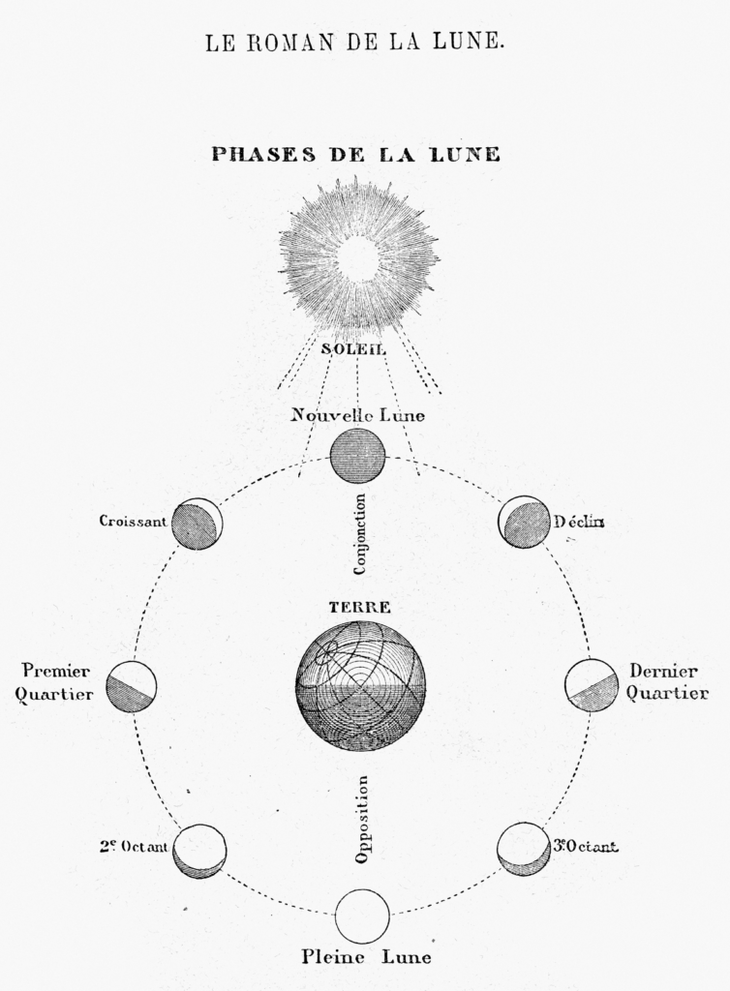Heading out the door? Read this article on the new Outside+ app available now on iOS devices for members! Download the app.
There’s no shortage of talk about the fully illuminated Moon. It is the muse of poets and artists and musicians and meme makers and everyday folks who feel compelled to remind others to “hey, go look at the Moon.” In astrology and in culture at large, you’ll happen upon far fewer mentions and celebrations of the new Moon (save perhaps for Pink Floyd’s tribute album to the dark side of the Moon). There’s seems to be something less lyrical about the new Moon, although no less magical. Out of sight and tidily out of mind, the Moon isn’t even apparent at night during the new phase, resulting in many of us needing to ask, when is the next new Moon?
The new Moon is the phase in the lunar cycle when the Moon’s orbit positions our rocky satellite in between the Earth and Sun. Because the Moon is lit by light reflecting off its surface, the new phase occurs in darkness, with the Sun’s light landing on the side turned away from Earth. During this time, we’re unable to even discern the Moon’s shape or placement in the cosmos.
That’s not a bad thing. Simply an underappreciated thing.

What Does the New Moon Mean?
Astrologers have long considered the new Moon to be no less significant than the full Moon. Rather, it simply emits a different vibe. The new Moon is traditionally considered a time when we, too, aren’t quite certain where we are. It is a time to explore our desires. It is a time of patient awareness, curiosity, and intentionality. Unlike the full Moon, when many seek obvious answers to their requests, the new Moon is a time of quiet awareness and curiosity.
Yet because the new Moon precedes the full Moon in the lunar cycle and is about setting intentions, much of contemporary astrology seems to be sidetracked by fervent intention-setting with the expectation that something will change by the new Moon that follows less than two weeks later. This emphasis on the immediate and tangible misinterprets more traditional understandings about the resonance of the new Moon, which are more about discerning our needs rather than demanding our wants. It is about allowing things to happen when the timing is aligned rather than expecting a delivery as if we had schedule it on Amazon.
Working with the Moon is not an entirely passive affair. But it is one that is filled with introspection and the accompanying shift in consciousness that must then be translated into our thoughts and reactions related to situations in everyday life. The magic of the new Moon can not be rushed.

When is the Next New Moon in 2024?
January 11 | New Moon in Capricorn
February 9 | New Moon in Aquarius
March 10 | New Moon in Pisces
April 8 | New Moon and Solar Eclipse in Aries
May 7 | New Moon in Taurus
June 6 | New Moon in Gemini
July 5 | New Moon in Cancer
August 4 | New Moon in Leo
September 2 | New Moon in Virgo
October 2 | New Moon and Solar Eclipse in Libra
November 1 | New Moon in Scorpio
November 30 | New Moon in Sagittarius
December 30 | New Moon in Capricorn
What Does a New Moon and Solar Eclipse Mean?
The simple answer, according to astronomy and physics, is that the Moon and Sun have fallen into a particular alignment. A solar eclipse can happen only at the new Moon, explains NASA in a post about eclipses, when the Moon literally blocks out the light of the Sun on a small part of the Earth. Because the Moon is tilted, NASA explains, there typically isn’t a complete eclipse during each new Moon. But a couple of times each year, the solar rays are effectively eclipsed by the Moon.
“That we often get such impressive solar eclipses on Earth is a lucky chance of nature,” explains the NASA post. “The Sun is vastly larger than the Moon—its diameter is about 400 times the Moon’s. But the Moon is roughly 400 times closer to Earth. This makes it possible for the Moon to almost perfectly block out the Sun when everything aligns.”
In less literal terms, according to astrology, a solar eclipse echos what is happening in the cosmos. It is a reminder of the constant tussle between dualities inherent in life that are beyond our understanding, let alone our control, whether light and dark or our conscious and unconscious self. These polarities are inherent in astrology’s understanding of life and are expressed in the zodiac circle itself and how each sign exists on an axis with its opposite sign. An eclipse is not about needing to know where you fall along any axis but simply becoming increasingly aware that there is an axis.
Although a new Moon is typically considered a time to set intentions, that is discouraged during a solar eclipse given the unusual and sometimes chaotic tensions at play. As the more subtle Moon overwhelms the more ostentatious Sun (take note, Cancers and Leos), it can be considered a time for turning within and simply being with those aspects of ourselves that are perhaps still dormant.